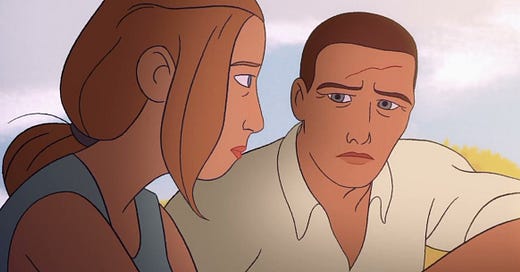Charlotte
An incredibly revealing and tragic portrait of a German-Jewish artist that demonstrates the power of animation to tell grown-up stories.
After the second Golden Age of animation dawned in the 1990s, we enjoyed 20 or so good years until things began to get moribund again. We got a lot of kiddie fare without much imagination or effort.
Yeah, I’m lookin’ at you, “The Emoji Movie.”
If there’s going to be a third wave of animated excellence, it might just be with movies like “Charlotte.” Like last year’s Oscar-nominated “Flee” or “Loving Vincent” from a few years back, it uses animation to explore real-life stories and issues in a serious, thoughtful way. While I wouldn’t rule out “Charlotte” for older kids, it contains mature content and is definitely aimed more at the adult art house crowd than the weekend multiplex.
It tells the true story of Charlotte Salomon, a German-Jewish painter, and tracks her childhood and young womanhood in 1930s Berlin. As the Nazi regime grows in power, her parents finally sent her away to live in the south of France in the early 1940s, but of course the war eventually followed her there.
Charlotte is voiced by Keira Knightley, who also is an executive producer on the film. (Marion Cotillard serves a corresponding function for the French language version.) It’s terrific, expressive work — showing Charlotte to be a daring artist who was also very much a prisoner of her time, place and family tradition.
Directed by Tahir Rana and Éric Warin from a screenplay by Erik Rutherford and David Bezmozgis, “Charlottte” uses a seemingly simplistic hand-drawn animation style without a lot of detail for the human figures. Though the backgrounds and, especially, the depictions of Saloman’s paintings are lush waves of color and lyrical form.
Salomon is best known for her massive series of autobiographical paintings, “Life? or Theatre?”, consisting of more than 1,000 works created during the time the film depicts. Some have called it the precursor to the graphic novel, so “Charlotte” the movie is really a chance for her painted story to be brought to animated life.
The daughter and granddaughter of successful doctors, Charlotte grew up somewhat in privilege. Though by 1933 when the story opens, the jackbooted squads of Hitler adherents were already starting to intrude into everyday life.
After the passing of her mother when she was 8, Charlotte throws herself into drawing and painting, seemingly to the exclusion of everything else. As a teen she is accepted into a prestigious art college despite her Jewish heritage. Her father (Eddie Marsan) is supportive, though her stepmother, Paula (Helen McCrory), a singer, worries about her being targeted.
Her expressionist style is very much at odds with the school’s focus on geometrically precise depiction of glorious German forms and mythology — she jokingly dubs her work “artistic deformities.”
Over time Charlotte grows an affection for Paula’s musical teacher, Alfred Wolfsohn (Mark Strong), a sensitive, bespectacled intellectual. He encourages her painting, even inviting her to illustrate his autobiography about his war experiences. But by 1938 things have grown dire, and her father is briefly detained in a concentration camp.
Charlotte is sent to the south of France to live with her grandparents, on the excuse that they are elderly and in need of care. In truth they have been taken in by Ottile Moore (Sophie Okonedo ), a German-American millionaire who owns a lavish estate.
Also a resident is Alexander Nagler (Sam Claflin), a kindly Austrian Jew who acts as the gardener, and takes Charlotte under his protective wing.
However, her rigid grandfather aka “grosspapa” (Jim Broadbent) soon insists they leave, not wanting to be beholden to Moore, or anyone. He wears a suit and tie everywhere he goes and is so insistent on maintaining his dignity, he carries a bottle of Veronal poison to kill himself and his wife should they ever run out of money or be captured by the Nazis.
Her grossmama (Brenda Blethyn) is haunted by her own dark memories and a thread of mental illness in the family that has led to a number of suicides (which often are hidden as drownings or other accidents). So Charlotte stays with them, despite being miserable and it cramping her ability to paint.
“Charlotte” is a vivid portrait of a young woman whose soul was meant to soar, but instead she was excluded, shoved aside, dismissed, abused and even hunted. Despite this, she managed to create something magical that still endures eight decades later.
It’s a wonderful, sad story told gorgeously through animation — one I think would not have worked nearly so well as a live-action picture.
The film opens this week in the major markets, and should roll out to the rest of the country soon.





